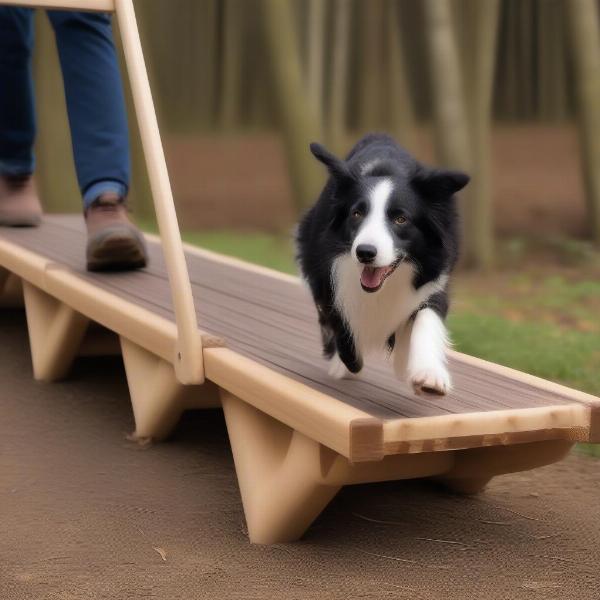Agility training offers a fantastic way to bond with your dog while providing them with essential physical and mental stimulation. Whether you’re a seasoned competitor or just starting out, having the right agility products for dogs is crucial for a successful and enjoyable experience. This article will guide you through the essential equipment you need, helping you choose the best products for your furry friend’s agility journey.
Essential Agility Products for Beginners
Starting with the basics is key. A few core pieces of equipment will allow you to introduce your dog to agility and build a strong foundation. These include:
- Agility Tunnel: Tunnels are a great starting point, teaching your dog body awareness and confidence. Look for collapsible tunnels that are easy to store and transport.
- Weave Poles: Weaving through poles improves coordination and focus. Start with a small number of poles and gradually increase as your dog progresses.
- Jumps: Adjustable height jumps allow you to customize the challenge for your dog’s size and skill level. Choose jumps with a broad base for stability.
Level Up Your Agility Training: Advanced Equipment
As your dog becomes more proficient, you can introduce more challenging equipment to keep them engaged and stimulated.
- A-Frame: The A-frame improves strength and balance. Ensure the surface provides adequate grip for your dog’s paws.
- Dog Walk: The dog walk teaches balance and coordination on a narrow, elevated platform. Look for dog walks with a non-slip surface and secure footing.
- Pause Table: The pause table teaches your dog impulse control and focus, requiring them to stay put for a designated time.
 Advanced Agility Equipment: Dog Walk
Advanced Agility Equipment: Dog Walk
Choosing the Right Agility Products: Factors to Consider
Several factors influence the best agility products for your dog.
- Dog’s Size and Breed: Consider your dog’s size and physical capabilities when selecting equipment. Smaller breeds might require smaller jumps and tunnels.
- Material and Durability: Choose products made from durable, weather-resistant materials to withstand outdoor use.
- Portability and Storage: If you plan to travel with your agility equipment, opt for collapsible and lightweight options.
- Safety Features: Look for equipment with rounded edges and non-slip surfaces to minimize the risk of injury.
Conclusion: Investing in Your Dog’s Agility Journey
Choosing the right agility products for dogs is an investment in their physical and mental well-being. By providing your dog with stimulating activities and challenges, you strengthen your bond and enhance their overall quality of life. Remember to start slowly, gradually increasing the difficulty as your dog progresses. With the right equipment and a positive training approach, agility can be a rewarding experience for both you and your furry companion.
FAQ
- What are the benefits of dog agility? Agility training improves a dog’s physical fitness, mental stimulation, and strengthens the bond with their owner.
- What age can a dog start agility training? While puppies can begin basic exercises, formal agility training is usually best started after they’re physically mature, around 1-2 years old.
- Is agility training suitable for all breeds? Most breeds can enjoy agility, but it’s important to consider your dog’s individual physical capabilities and health.
- What if my dog is hesitant to try agility equipment? Patience and positive reinforcement are key. Start with easy exercises and gradually introduce new equipment.
- Where can I find reputable agility products for dogs? Reputable pet supply stores and online retailers offer a wide selection of agility equipment. Look for brands known for quality and safety.
- How much space do I need for agility training? You can start with a relatively small space, such as your backyard. As your dog progresses, you may want to consider joining an agility club with a larger training area.
- How often should I train my dog in agility? Start with short sessions a few times a week and gradually increase the duration and frequency as your dog builds strength and stamina.
Suggested Further Reading on ILM Dog
About ILM Dog: ILM Dog is your trusted international resource for expert advice on dog care and training. We offer comprehensive information on breed selection, health, nutrition, training, and much more. Whether you’re a first-time dog owner or a seasoned expert, our articles provide practical tips and insights to help you provide the best possible care for your canine companion. From choosing the right lead rope dog for walks to understanding the benefits of hunting squirrels with dogs for certain breeds, ILM Dog has you covered. Contact us at [email protected] or +44 20-3965-8624 for personalized advice. good release commands for dogs can greatly enhance your training sessions, and you can find more information on our website.